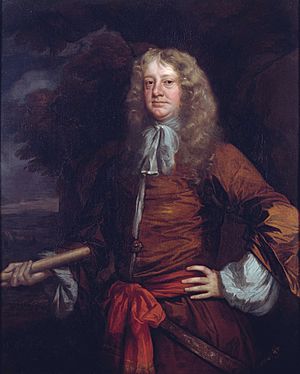George Ayscue facts for kids
Quick facts for kids
Sir George Ayscue
|
|
|---|---|

Admiral Sir George Ayscue by Sir Peter Lely, painted 1665–1666, part of the Flagmen of Lowestoft series.
|
|
| Born | 1616 |
| Died | 5 April 1672 Westminster, London |
| Buried |
St Margaret's Church, Westminster, England
|
| Allegiance | |
| Service/ |
|
| Years of service | 1646–1672 |
| Rank | Admiral of the White |
| Commands held | Admiral of the Irish Seas |
| Battles/wars | Battle of Plymouth Battle of Lowestoft Four Days' Battle |
Sir George Ayscue (born around 1616, died April 5, 1672) was an important English naval officer. He served during a time of big changes in England. These included the English Civil War and wars against the Dutch. He became a high-ranking officer, known as an Admiral of the White. Sir George also worked as a governor. He governed the Scilly Isles in 1647. Later, he was the Governor of Barbados from 1650 to 1652.
Contents
Who Was Sir George Ayscue?
George Ayscue came from an old family in Lincolnshire, England. King Charles I made him a knight in 1641. This was a special honor. In 1646, he started his career in the navy.
In August 1647, Ayscue became the Governor of the Scilly Isles. He held this job until January 1648. During the English Civil War, he was a captain in the English Parliament's navy. He was good at keeping sailors loyal. Because of this, he was given command of two ships. He was also promoted to Rear Admiral in 1648.
In 1649, he became the Admiral of the Irish Seas. This meant he was in charge of ships around Ireland. The next year, in 1650, he became Governor of Barbados. He also commanded the ships sent to that island.
Capturing Islands
In 1651, Sir George worked with another famous admiral, Robert Blake. Together, they captured the Scilly Isles. These islands had been held by people loyal to the King. Later that year, Ayscue captured Barbados from Lord Willoughby. He also took control of other English colonies in the Americas.
Wars Against the Dutch
Sir George Ayscue fought in the First Anglo-Dutch War. This was a big naval conflict. In one battle, the Battle of Plymouth, he was defeated by a Dutch commander named Michiel de Ruyter. After this, he was removed from his command. He then went to work for the Swedish Navy for a while.
He returned to England after Charles II became king again. This event is called the Restoration. In 1664, Ayscue was made Rear-Admiral of the Blue Squadron. The next year, in June 1665, he became Vice-Admiral of the Blue. He commanded a group of ships at the Battle of Lowestoft in 1665. This was during the Second Anglo-Dutch War.
Capture and Later Life
In February 1666, he was promoted to Admiral of the Blue. Then, at the start of the Four Days' Battle in June 1666, he became Admiral of the White. This was a very high rank. His main ship, Prince Royal, got stuck on a sandbank. This meant he had to surrender his ship to the Dutch.
Sir George Ayscue became the highest-ranking English naval officer ever captured by an enemy. He was held as a prisoner in a Dutch prison called Loevestein. After this, he likely never went to sea as an admiral again.
In December 1671, he led a special court meeting. This meeting was to judge another admiral, Sir William Jennings. Sir George Ayscue was still a serving officer when he passed away. He died at his home in Westminster, London on April 5, 1672. He was buried on April 13, 1672, at St Margaret's Church, Westminster, in London.

